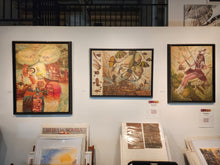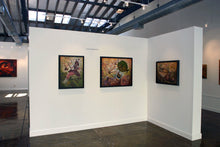
This is a re-imagining of one of Huerta's classic masterworks, that was done in the early 2000's, and was quickly scooped up, by a fortunate collector. It is spectacular work. In our opinion, the detail is far more realized than the painting it was inspired by.
Description - h: 40 x w: 30 in - 100 x 75cm.
2023 - oil on canvas
Permanent collections:
University of Arizona Museum of Art, Tucson, Arizona, Tucson Museum of Art, Tucson, Arizona
Estremadura Museum of Art, Estremadura, Spain
Extracted from an article in Tucson Weekly, on August 23, 2007, written by Margaret Regan:
In "Caerse de Habana" (The Fall of Havana), 2002, three old men are struggling to hold up a figure above their bald heads. They're decrepit caryatids long past their prime, but then so is the strongman they're trying to support. He's a fake, his body made of wood, pegged together at the joints, and he's collapsing. But Huerta's vision is too wild, too erotic--and too much fun--to be reined in by a single interpretation tied to contemporary politics. Elephant-headed old folks dance on a gargantuan pink birthday cake in "Feliz Cumpleaños" (Happy Birthday), 2003, just beyond a giant snake slithering in the hay around it. Above, the heads of four angry gods blow the small brushfire atop the cake into a conflagration. In other works, a tiny family sits on the precipice of a stove, just past a pot of boiling ship. A sexy woman with a cat's head writhes all naked on the shoulders of a man with a dog's head. Workmen on scaffolding lazily touch up the paint job on the face of a giant man.
Huerta practices what the Cubans call "lo real maravilloso" (the marvelous real), a counterpart to the magical realism in Latin-American literature. He counterbalances the realistic and the fantastic, placing recognizable figures, landscapes and buildings in impossible settings. He plays with imbalances of scale--see that mini-family on the stovetop--and "irrational space," juxtaposing sailing teacups with sailing ships.
Beautifully rendered in acrylics on canvas, his paintings are meant to look like oils, says Lisa Fischman, University Of Arizona Museum of Art curator. Even to the point that he's faked the sheen of oil glaze on top. He paints in a limited Old World palette, in browns, golds, yellows and ambers, with jolts of pale blue or red here and there. Some passages are thinly stained with color, while others have deft layerings of thick paint. Occasionally, Huerta allows paint to drip vertically all across the canvas, like rain, or tears.
The landscape of Cuba, often a backdrop to the fantastic goings-on, emerges in soft, blurry rows of palm trees and glints of light on rooftops. The sea greens of the Straits of Florida shimmer, and sunset skies turn chalky yellow.
The Old Masters can take credit for some of Huerta's wildness. His crazy machines have their roots in Leonardo da Vinci's drawings of flying contraptions, moving dykes, pulleys and cranks. Huerta's fantastic creatures, half-human, half-animal, and his apocalyptic visions owe a debt to Hieronymus Bosch. And his imagination, Fischman says, follows the free flights of Francisco Goya.
Which is how Huerta's works came to be displayed at the UAMA. Fischman and assistant curator Susannah Maurer were looking for a contemporary artist to pair with the second installment of the museum's four-part Goya etchings series. Last spring, works by Tucson rodeo photographer Louise Serpa went up next door to Goya's La Tauromaquia suite of bullfighting prints. This second Goya show, now on view, exhibits 24 etchings from Los Disparates, which the museum translates as "mad and absurd ideas", along with 20 paintings by Victor Huerta Batista. Filled with grotesque monsters, dreamlike phantoms and humans with bats' wings, the nightmare Disparates images are bathed in darkness. Goya worked on these pictures at the end of his life, and scholars have debated whether they represent his fears of death, or his horror at the catastrophic wars of his lifetime, or something else altogether. In any case, the curators thought, rightly, that Huerta's unruly work was a good match. They found his work via the MLA Gallery in Los Angeles, which handles his work and acted as intermediary. Huerta has had some success in Cuba, but this is the first time his extravagant visions have won a museum show in the United States.
"His imagination is unloosed," Fischman says. "He's an artist willing to see where that goes. That's a precedent that Goya set."
Correspondence: In Relation to Goya paintings by Victor Huerta Batista
Goya's Mastery in Prints: Los Disparates
University of Arizona Museum of Art, through Sept. 30th, 2007
Excerpts, and paintings on loan courtesy of MLA Gallery
For more info call us at (323) 744-7550, or to see a greater selection of the gallery work, please visit our Artnet site at:











